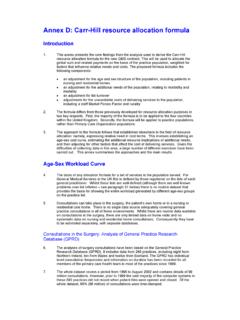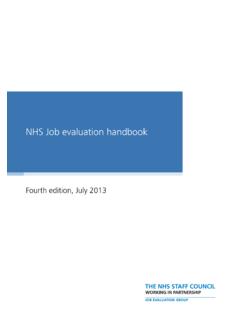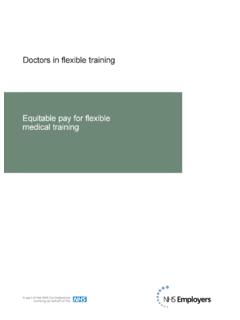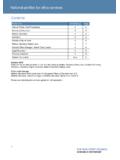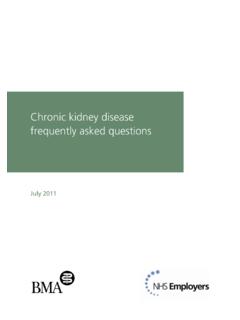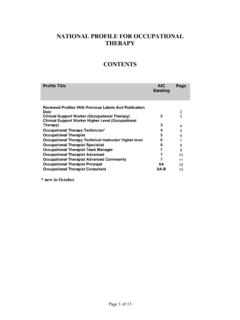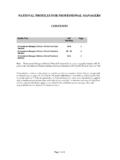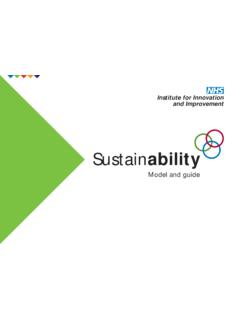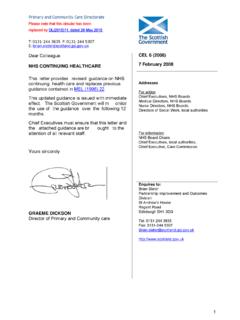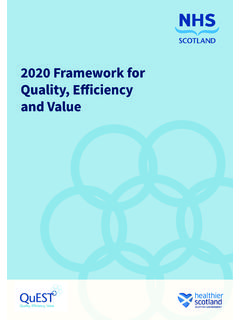Transcription of On-call implementation guidance - FINAL - NHS …
1 1 On-call implementation guidance This implementation guidance has been produced to accompany the agreed principles in annex A3 of the NHS terms and conditions of service handbook for harmonised On-call arrangements, to support local partnerships in their negotiations and to provide clarity on terms and references. Where possible, the guidance takes into account the feedback from the consultation on the principles, and seeks to clarify issues raised in those responses. The On-call working group of the NHS Staff Council will review this guidance periodically, between now and April 2011 and will issue updates as required.
2 Section one It is expected that employing organisations will work in partnership with recognised NHS trade unions via the relevant forum to undertake both the collection of data on current On-call systems and negotiations to develop and agree harmonised arrangements. A range of terminology is used to describe what is covered by the scope of the On-call review . It is important that information is collected about all of those schemes or arrangements which are currently designated as On-call including those described as sleeping-in.
3 It is for local partnerships to determine appropriate arrangements for involvement and governance for the project - to identify who is going to undertake the various elements of the work and how the involvement of representatives from all staff groups will be secured, especially from those where On-call working is common. Partners will need to identify: What structures need to be put in place to gather data and negotiate new arrangements What communications need to be prepared to ensure consistent messages are communicated to staff How staff will be consulted on any agreed proposals How affected staff will be notified of new pay arrangements and rates for On-call .
4 That are agreed locally What arrangements will apply if negotiations are not completed in time to process new payments from 1 April 2011 What ongoing monitoring will be put in place following the introduction of an agreed scheme, and who will be involved in this Along with collecting data on current On-call schemes, local partnerships will also need to take into account any service specifications for particular types of work which may impose particular service requirements for the way that On-call is provided.
5 2 Section two Definition On-call systems exist as part of arrangements to provide appropriate service cover across the NHS. A member of staff is On-call when, as part of an established arrangement with his/her employer, he/she is available outside his/her normal working hours either at the workplace, at home or elsewhere to work as and when required. This definition emphasises that the core element of On-call is the agreement to be available outside normal working hours. Normal working hours are those which are regularly worked and/or fixed by contract of employment.
6 Time worked as overtime is not normal work unless an employee s contract fixes a minimum number of hours. Principle guidance 1. Equal pay The guiding principle should be that the harmonised arrangements should be consistent with the principles of equal pay for work of equal value The effect of this should be that schemes agreed by local partnerships should provide consistent payments to staff at the same pay band available at the same On-call frequency.
7 Once local negotiations have been completed, it will be necessary to undertake an Equality Impact Assessment before agreeing any FINAL policy . It may be helpful to identify at the outset of the project the model that it is intended to be used for this purpose. More information and a guide to conducting impact assessments is available from: 3 2. Commitment or availability payment There needs to be a payment to reflect the availability for being called. There are three distinct types of On-call availability: (a) at home ready to be called out or to undertake work at the work place; (b) at work ready to undertake work; (c ) sleeping in at a work place.
8 Payment for these different types of availability options include: (a) flat rate available for all staff; (b) flat rate by grade; (c ) percentage of salary. This payment will reflect the frequency of commitment. If the partnership decides to use a flat rate they will need to agree arrangements for uprating this payment when pay increases. In setting the availability payment, local partnerships will need to take account of the commitment to work weekends and public holidays. Where tiered On-call systems are required, there should be no distinction between levels of commitment when setting the availability/commitment payment.
9 Reference paragraph to in the NHS terms and conditions of service handbook, to allow the option of prospective calculation of the payments. You will need to set a payment or payment formula for each of the three described types of On-call in place in your organisation, with reference to the standard frequencies in principle 3. Where On-call arrangements cover evenings and weekends with different frequencies, this will need to be taken into account in setting the payment (see principle 3). You will need to consider the pros and cons of each approach and particularly the cost implications of these options.
10 If you agree to apply a flat rate for availability, it will be necessary to identify how and when these are uprated, for example, in line with pay uplifts to the Agenda for Change pay scales. Where On-call activity commonly includes staff from a range of pay bands, local partnerships may wish to consider a flat rate for the availability payment. On-call for supervisors of midwives is consistent with type 1 on call at home ready to be called out to a workplace. The principles identify that the availability payment should not distinguish between different tiers of On-call .

